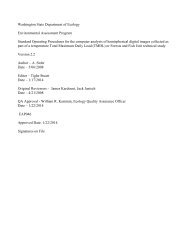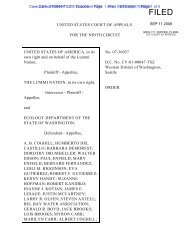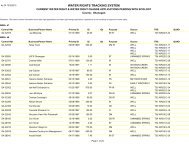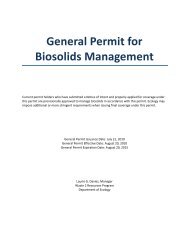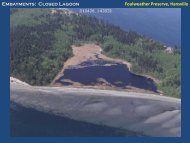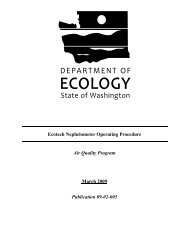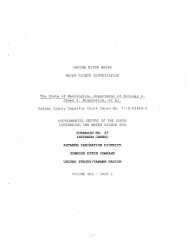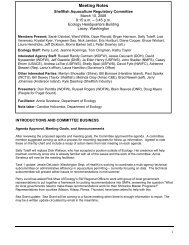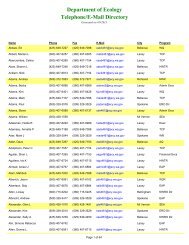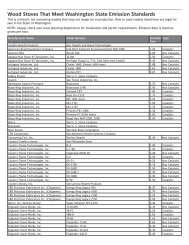WRIA 62 WMP 032305 - Washington State Department of Ecology
WRIA 62 WMP 032305 - Washington State Department of Ecology
WRIA 62 WMP 032305 - Washington State Department of Ecology
Create successful ePaper yourself
Turn your PDF publications into a flip-book with our unique Google optimized e-Paper software.
March, 2005 -82- 023-1289-003.3040<br />
• Facilitates coordination and cooperation between local natural resource and fisheries<br />
managers concerning specific projects, efforts, and strategies; and,<br />
• Identifies methods <strong>of</strong> building public support for native salmonid recovery in <strong>WRIA</strong> <strong>62</strong>.<br />
Funding for habitat improvement projects needed for native salmonid recovery is administered by the<br />
<strong>State</strong> Salmon Recovery Funding Board (SRFB). Applications for this funding within the Pend<br />
Oreille Watershed are prioritized by the Pend Oreille Salmonid Recovery Team, then submitted to the<br />
SRFB. Grants for the 5 th Round Funding Cycle by the Salmon Recovery Funding Board were<br />
announced December 9, 2004. Funding received for work to be completed in the Pend Oreille<br />
Watershed is as follows:<br />
• $725,144 to the Town <strong>of</strong> Ione for removing the Cedar Creek Dam to allow fish<br />
migration;<br />
• $85,563 to the Pend Oreille Conservation District for assessing the barriers to fish<br />
migration in the Priest River basin; and,<br />
• $113,735 to the Pend Oreille Conservation District for improving fish passage in Indian<br />
Creek.<br />
5.1.3 Federal Endangered Species Act (ESA) Bull Trout Recovery Planning<br />
The U.S. Fish and Wildlife Service (USFWS) issued a final rule listing the Columbia River and<br />
Klamath River populations <strong>of</strong> bull trout (Salvelinus confluentus) as Threatened under the ESA on<br />
June 10, 1998 (63 FR 31647). As a result, the USFWS is developing recovery planning strategies for<br />
bull trout populations throughout <strong>Washington</strong>. A draft plan was released in 2002. A team <strong>of</strong> local<br />
biologists, including several from the Pend Oreille Salmonid Recovery Team Technical Advisory<br />
Group, assisted in development <strong>of</strong> the plan.<br />
To facilitate the recovery planning process and avoid duplication <strong>of</strong> effort, the recovery team adopted<br />
the logistical framework proposed in the 1999 draft statewide strategy to recover salmon entitled<br />
“Extinction Is Not an Option” (WGSRO, 1999). As recommended in this draft strategy, bull trout<br />
recovery planning areas (or “recovery units”) overlap the state’s salmon recovery regions. The use <strong>of</strong><br />
recovery units will allow for better coordination during salmon and bull trout recovery planning and<br />
implementation. The Northeast <strong>Washington</strong> Recovery Unit is one <strong>of</strong> 22 recovery units designated for<br />
bull trout in the Columbia River Basin.<br />
The geographic area for Bull Trout Recovery under ESA Planning is broader than that <strong>of</strong> Watershed<br />
Planning (per Chapter 90.82 RCW). The Northeast <strong>Washington</strong> Recovery Unit encompasses the<br />
mainstem Columbia River and tributaries above Chief Joseph Dam up to the Canadian border. Major<br />
tributaries include the San Poil, Spokane, Kettle, Colville and Pend Oreille rivers. Based on survey<br />
data and pr<strong>of</strong>essional judgment, the Northeast <strong>Washington</strong> Recovery Unit Team identified one core<br />
area (Pend Oreille River) in the recovery unit. For the purposes <strong>of</strong> recovery, a core area represents<br />
the closest approximation <strong>of</strong> a “biologically functioning unit.” Core areas consist <strong>of</strong> core habitat that<br />
could supply all the necessary elements for every life stage <strong>of</strong> bull trout (e.g., spawning, rearing,<br />
migratory, and adult), and have one or more groups <strong>of</strong> bull trout. Core areas are the basic units by<br />
which recovery within a recovery unit is gauged.<br />
<strong>WRIA</strong> <strong>62</strong> <strong>WMP</strong> <strong>032305</strong>



